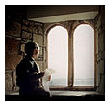 In the twelfth century, the legends of King Arthur were enthusiastically embraced by the French. Lancelot appeared and was made famous in The Knight of the Cart, a poem by Chrétien de Troyes. Chrétien’s less famous foray into the world of Camelot is his poem, Erec and Enid.
In the twelfth century, the legends of King Arthur were enthusiastically embraced by the French. Lancelot appeared and was made famous in The Knight of the Cart, a poem by Chrétien de Troyes. Chrétien’s less famous foray into the world of Camelot is his poem, Erec and Enid.
In her essay Erec and Enide—Cosmic Measures in Nature and the Hebrew Heritage, Joan Helm looked at the significance of the numbers 1111 and 1742 within the poem’s structure. She connected 1111 to the mathematics of the City of God in the prophecy of Ezekiel and ultimately to the ‘kiss of heaven and earth’. There are other medieval poems with the same motif and numeric design.
Helm was a scholar at the University of Queensland who became internationally renowned for her discovery of mathematical architecture within Old French texts. She makes the point in Erec and Enid, moreover, that the old English land measurement system is not a hodgepodge but a deliberate construction, meant to reflect Ezekiel’s town plan of the New Jerusalem with its built-in 1111s. It seems to have been an ancient tradition that when heaven comes down to touch earth, somewhere below the orbit of the moon, there was a uniquely appropriate mathematical way to express it: using a series of ones.
Which is why I find this curious fact delightfully amusing: the Hubble Space Telescope weighs 11110 kg.


It is interesting that it’s number one’s, since 1 is kind of a whole, in my mind. And unifying things together into one whole entity seems to be a characteristic of God in many areas. I see this also in philosophy and worldviews…since they have been “secularised”, it seems to have been divided into many disciplines and opinions. Ephesians 1:10 says this well (there’s those ones again):
“to gather up all things in him, things in heaven and things on earth.”